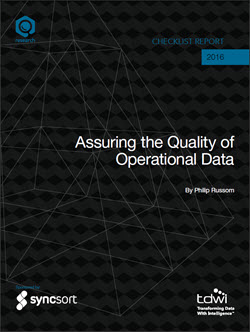
TDWI Checklist Report | Assuring the Quality of Operational Data
June 22, 2016
Failing to ensure high-quality operational data may put many worthwhile business goals for operational excellence at risk. For example, a Zero Defect or Six Sigma program in manufacturing needs clean, complete, consistent, and current operational data that quantifies supplies, suppliers, and products (both on the product floor and in the field). As another example, sales and marketing initiatives need cleansed, standardized, and enhanced operational data drawn from customer-facing
operational applications and third-party providers if they want to increase conversion rates via better-targeted campaigns.
Likewise, there are many other areas within the average enterprise where high-quality operational data contributes to operational excellence:
-
Squeaky clean and auditable financial data for regulatory and financial reports
-
Standards for sharing product and financial data with related business units and partners
-
Standards for data-driven processes
-
Complete 360-degree views of customers, products, and other key business entities
-
Trusted metrics and key performance indicators for operational business intelligence (BI) and data warehousing (DW)
-
Geocodes to pinpoint physical assets, customers, and locations of significant events
In all these examples, people, processes, organizational structures, data, software, and other resources are already in place and operating, so this report provides recommendations for incrementally and continuously improving the quality of operational data, which in turn contributes to an organization’s drive toward operational excellence.